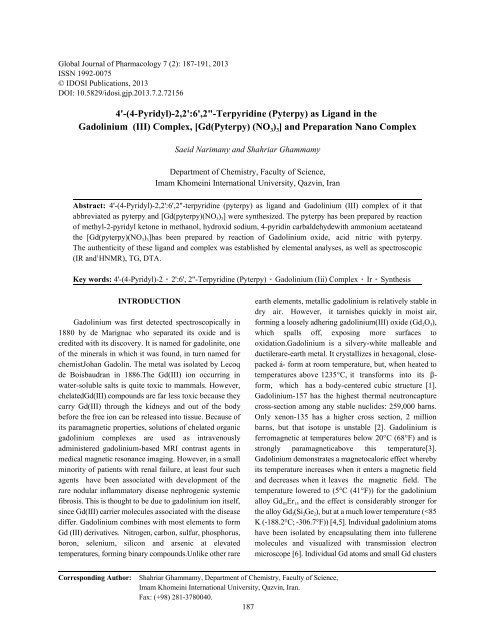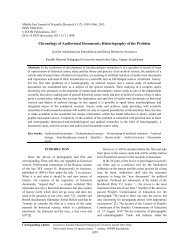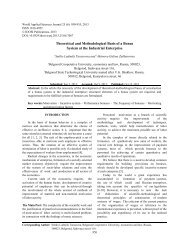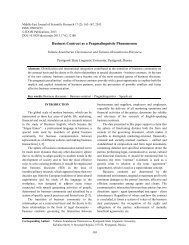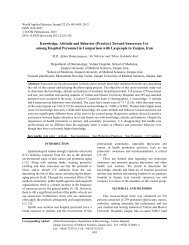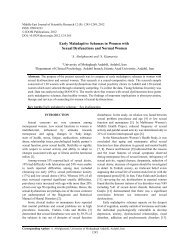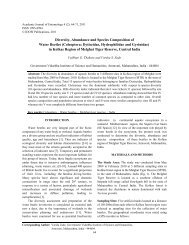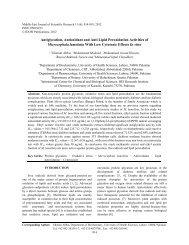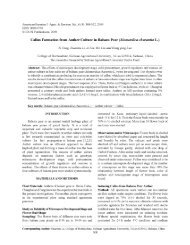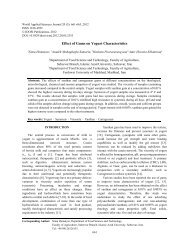4'-(4-Pyridyl)-2,2':6',2"-Terpyridine (Pyterpy) as Ligand in the ...
4'-(4-Pyridyl)-2,2':6',2"-Terpyridine (Pyterpy) as Ligand in the ...
4'-(4-Pyridyl)-2,2':6',2"-Terpyridine (Pyterpy) as Ligand in the ...
You also want an ePaper? Increase the reach of your titles
YUMPU automatically turns print PDFs into web optimized ePapers that Google loves.
Global Journal of Pharmacology 7 (2): 187-191, 2013<br />
ISSN 1992-0075<br />
© IDOSI Publications, 2013<br />
DOI: 10.5829/idosi.gjp.2013.7.2.72156<br />
<strong>4'</strong>-(4-<strong>Pyridyl</strong>)-2,<strong>2'</strong>:<strong>6'</strong>,2"-<strong>Terpyrid<strong>in</strong>e</strong> (<strong>Pyterpy</strong>) <strong>as</strong> <strong>Ligand</strong> <strong>in</strong> <strong>the</strong><br />
Gadol<strong>in</strong>ium (III) Complex, [Gd(<strong>Pyterpy</strong>) (NO ) ] and Preparation Nano Complex<br />
3 3<br />
Saeid Narimany and Shahriar Ghammamy<br />
Department of Chemistry, Faculty of Science,<br />
Imam Khome<strong>in</strong>i International University, Qazv<strong>in</strong>, Iran<br />
Abstract: <strong>4'</strong>-(4-<strong>Pyridyl</strong>)-2,<strong>2'</strong>:<strong>6'</strong>,2"-terpyrid<strong>in</strong>e (pyterpy) <strong>as</strong> ligand and Gadol<strong>in</strong>ium (III) complex of it that<br />
abbreviated <strong>as</strong> pyterpy and [Gd(pyterpy)(NO 3) 3] were syn<strong>the</strong>sized. The pyterpy h<strong>as</strong> been prepared by reaction<br />
of methyl-2-pyridyl ketone <strong>in</strong> methanol, hydroxid sodium, 4-pyrid<strong>in</strong> carbaldehydewith ammonium acetateand<br />
<strong>the</strong> [Gd(pyterpy)(NO 3) 3]h<strong>as</strong> been prepared by reaction of Gadol<strong>in</strong>ium oxide, acid nitric with pyterpy.<br />
The au<strong>the</strong>nticity of <strong>the</strong>se ligand and complex w<strong>as</strong> established by elemental analyses, <strong>as</strong> well <strong>as</strong> spectroscopic<br />
1<br />
(IR and HNMR), TG, DTA.<br />
Key words: <strong>4'</strong>-(4-<strong>Pyridyl</strong>)-2 <strong>2'</strong>:<strong>6'</strong>, 2"-<strong>Terpyrid<strong>in</strong>e</strong> (<strong>Pyterpy</strong>) Gadol<strong>in</strong>ium (Iii) Complex Ir Syn<strong>the</strong>sis<br />
INTRODUCTION<br />
earth elements, metallic gadol<strong>in</strong>ium is relatively stable <strong>in</strong><br />
dry air. However, it tarnishes quickly <strong>in</strong> moist air,<br />
Gadol<strong>in</strong>ium w<strong>as</strong> first detected spectroscopically <strong>in</strong> form<strong>in</strong>g a loosely adher<strong>in</strong>g gadol<strong>in</strong>ium(III) oxide (Gd2O 3),<br />
1880 by de Marignac who separated its oxide and is which spalls off, expos<strong>in</strong>g more surfaces to<br />
credited with its discovery. It is named for gadol<strong>in</strong>ite, one oxidation.Gadol<strong>in</strong>ium is a silvery-white malleable and<br />
of <strong>the</strong> m<strong>in</strong>erals <strong>in</strong> which it w<strong>as</strong> found, <strong>in</strong> turn named for ductilerare-earth metal. It crystallizes <strong>in</strong> hexagonal, closechemistJohan<br />
Gadol<strong>in</strong>. The metal w<strong>as</strong> isolated by Lecoq packed á- form at room temperature, but, when heated to<br />
de Boisbaudran <strong>in</strong> 1886.The Gd(III) ion occurr<strong>in</strong>g <strong>in</strong> temperatures above 1235°C, it transforms <strong>in</strong>to its -<br />
water-soluble salts is quite toxic to mammals. However, form, which h<strong>as</strong> a body-centered cubic structure [1].<br />
chelatedGd(III) compounds are far less toxic because <strong>the</strong>y Gadol<strong>in</strong>ium-157 h<strong>as</strong> <strong>the</strong> highest <strong>the</strong>rmal neutroncapture<br />
carry Gd(III) through <strong>the</strong> kidneys and out of <strong>the</strong> body cross-section among any stable nuclides: 259,000 barns.<br />
before <strong>the</strong> free ion can be rele<strong>as</strong>ed <strong>in</strong>to tissue. Because of Only xenon-135 h<strong>as</strong> a higher cross section, 2 million<br />
its paramagnetic properties, solutions of chelated organic barns, but that isotope is unstable [2]. Gadol<strong>in</strong>ium is<br />
gadol<strong>in</strong>ium complexes are used <strong>as</strong> <strong>in</strong>travenously ferromagnetic at temperatures below 20°C (68°F) and is<br />
adm<strong>in</strong>istered gadol<strong>in</strong>ium-b<strong>as</strong>ed MRI contr<strong>as</strong>t agents <strong>in</strong> strongly paramagneticabove this temperature[3].<br />
medical magnetic resonance imag<strong>in</strong>g. However, <strong>in</strong> a small Gadol<strong>in</strong>ium demonstrates a magnetocaloric effect whereby<br />
m<strong>in</strong>ority of patients with renal failure, at le<strong>as</strong>t four such its temperature <strong>in</strong>cre<strong>as</strong>es when it enters a magnetic field<br />
agents have been <strong>as</strong>sociated with development of <strong>the</strong> and decre<strong>as</strong>es when it leaves <strong>the</strong> magnetic field. The<br />
rare nodular <strong>in</strong>flammatory dise<strong>as</strong>e nephrogenic systemic temperature lowered to (5°C (41°F)) for <strong>the</strong> gadol<strong>in</strong>ium<br />
fibrosis. This is thought to be due to gadol<strong>in</strong>ium ion itself, alloy Gd85Er 15 and <strong>the</strong> effect is considerably stronger for<br />
s<strong>in</strong>ce Gd(III) carrier molecules <strong>as</strong>sociated with <strong>the</strong> dise<strong>as</strong>e <strong>the</strong> alloy Gd 5(Si 2Ge 2),<br />
but at a much lower temperature (
Global J. Pharmacol., 7 (2): 187-191, 2013<br />
have also been <strong>in</strong>corporated <strong>in</strong>to carbon nanotubes [7]. of <strong>4'</strong>-(4-<strong>Pyridyl</strong>)-2, <strong>2'</strong>:<strong>6'</strong>, 2"-terpyrid<strong>in</strong>e (pyterpy) with<br />
<strong>Terpyrid<strong>in</strong>e</strong> (2,<strong>2'</strong>;<strong>6'</strong>,2"-terpyrid<strong>in</strong>e) is a heterocyclic<br />
1<br />
Gadol<strong>in</strong>ium (III)and identification <strong>the</strong>m with IR, HNMR,<br />
compound derived from pyrid<strong>in</strong>e. This colourless solid TG and DTA<br />
is used <strong>as</strong> a ligand <strong>in</strong> coord<strong>in</strong>ation chemistry.<br />
<strong>Terpyrid<strong>in</strong>e</strong> is a tridentate ligand that b<strong>in</strong>ds metals at<br />
MATERIALS AND METHODS<br />
three meridional sites giv<strong>in</strong>g two adjacent 5-membered<br />
MN2C 2chelate r<strong>in</strong>gs [8]. Gadol<strong>in</strong>ium comb<strong>in</strong>es with most All reagents were supplied by Merck and<br />
elements to form Gd(III) derivatives. nitrogen, carbon, were used without fur<strong>the</strong>r purification. The FT-IR<br />
sulfur, phosphorus, boron, selenium, silicon and spectra were recorded <strong>in</strong> <strong>the</strong> range 400–4000 cm<br />
1<br />
by KBr<br />
arsenic at elevated temperatures, form<strong>in</strong>g b<strong>in</strong>ary disk us<strong>in</strong>g a Bruker Tensor 27 M 420 FT-IR<br />
compounds [9]. <strong>Terpyrid<strong>in</strong>e</strong> forms complexes with spectrophotometer.<br />
most transition metalion <strong>as</strong> do o<strong>the</strong>r polypyrid<strong>in</strong>e<br />
compounds, such <strong>as</strong> 2,<strong>2'</strong>-bipyrid<strong>in</strong>e and 1,10- Syn<strong>the</strong>sis of <strong>the</strong> <strong>4'</strong>-(4-pyridyl)-2, <strong>2'</strong>:<strong>6'</strong>, 2"-terpyrid<strong>in</strong>e<br />
phenanthrol<strong>in</strong>e. Complexes conta<strong>in</strong><strong>in</strong>g two terpyrid<strong>in</strong>e (<strong>Pyterpy</strong>): The ligand pyterpy w<strong>as</strong> prepared by a reported<br />
n+<br />
complexes, i.e. [M(terpy) 2] are common. They differ<br />
1<br />
method [11]. Yield: 85%. M.p. 230-232°C, IR (KBr, /cm ):<br />
n+<br />
structurally from <strong>the</strong> related [M(bipy) 3] complexes <strong>in</strong> 3050 (aromatic C-H stretch), 1475, 1585 (aromatic C=C<br />
be<strong>in</strong>g achiral. <strong>Terpyrid<strong>in</strong>e</strong> complexes, like o<strong>the</strong>r<br />
1<br />
stretch), 1390 (C=N stretch). H NMR (300 MHz, DMSO,<br />
polypyrid<strong>in</strong>e complexes, exhibit characteristic optical and ppm): 7.54 (dd, J = 4.8, 6.15 Hz, 2H, H f), 7.94 (d, J = 4.8 Hz,<br />
electrochemical properties: metal-to-ligand charge transfer 2H, H b), 8.04 (t, J = 7.8 Hz, 2H, H e), 8.68 (d, J = 7.8 Hz,<br />
(MLCT) <strong>in</strong> <strong>the</strong> visible region, reversible reduction and 2H, H g), 8.76 (s, 2H, H c), 8.76-8.77 (4H, H a, H d). UV-Vis<br />
oxidation and fairly <strong>in</strong>tense lum<strong>in</strong>escence. Because <strong>the</strong>y (H2O, max/nm): 198, 238, 272, 312.(Fig 1, 2, Table1).<br />
are pi-acceptors, terpyrid<strong>in</strong>e and bipyrid<strong>in</strong>e tend to<br />
stabilize metals <strong>in</strong> lower oxidation states. For <strong>in</strong>stance <strong>in</strong> Syn<strong>the</strong>sis of <strong>the</strong> [Gd(pyterpy)(No 3) 3]complex<br />
acetonitrile solution, it is possible to generate <strong>the</strong> Refluxmethod: At first Gadol<strong>in</strong>ium oxide (0.25 mmol,<br />
+<br />
[M(terpyrid<strong>in</strong>e) 2] (M = Ni, Co). In recent years 0.091 g) reacted with nitric acid (1.5 mmol)<br />
considerable attention h<strong>as</strong> been drawn to <strong>the</strong> polymetallic tobeconvertedtogadol<strong>in</strong>iumnitrate(0.5mmol) were<br />
coord<strong>in</strong>ation architectures ma<strong>in</strong>ta<strong>in</strong>ed by covalent and dissolved <strong>in</strong> ammoniac and <strong>the</strong> below complex w<strong>as</strong><br />
non-covalent (supramolecular) <strong>in</strong>teractions <strong>in</strong> <strong>the</strong> formed. The result<strong>in</strong>g product w<strong>as</strong> heated until gado<br />
solid-state [10]. The N-donorsligands have been ei<strong>the</strong>r l<strong>in</strong>iumnitrate completely dry. Then <strong>the</strong> result<strong>in</strong>g<br />
exo-bidentate (divergent) [2–9] or chelat<strong>in</strong>g bis-bidentate productw<strong>as</strong> dissolved <strong>in</strong> methanol (2 ml). At <strong>the</strong> next<br />
[10].In this paper we report preparation of a new complex stage pyterpy (0.05 mmol, 0.016 g) w<strong>as</strong> dissolved <strong>in</strong><br />
Fig. 1: FTIR spectrum of pyterpy (KBr Disk)<br />
188
Global J. Pharmacol., 7 (2): 187-191, 2013<br />
1<br />
Fig 2: HNMR spectrum of pyterpy(<strong>in</strong> DMSO)<br />
Fig. 3: FTIR spectrum of [Gd(pyterpy)(NO3)3] (KBr Disk)<br />
Table1: FTIR spectral data (cm<br />
1) of pyterpy<br />
1<br />
(cm ) Vibration Intensity<br />
3050 w<br />
C-H<br />
1475 M<br />
C=C<br />
1585 s<br />
C=C<br />
1390 s<br />
C=N<br />
1<br />
Table 2: FTIR spectral data (cm ) of [Gd(pyterpy)(NO 3) 3]<br />
1<br />
(cm ) Vibration Intensity<br />
3085 w<br />
C-H<br />
1605 M<br />
C=C<br />
1478 s<br />
C=C<br />
1413 w<br />
C=N<br />
1291 s<br />
(NO3)<br />
methanol and added to <strong>the</strong> first solution. The result<strong>in</strong>g<br />
solution w<strong>as</strong> refluxed at 65°C and after one hour <strong>the</strong><br />
result<strong>in</strong>g white precipitate w<strong>as</strong> filtered. Yield 55%,<br />
1<br />
M.P.>300°C, white solid; IR (Kbr, /cm ): 3082<br />
(C-H arom), 1605, 1478 (aromatic C=C stretch), 1413 (C=N<br />
stretch), 1291 (NO 3), 1161, 1021, 797. UV-Vis (H2O,<br />
max/nm): 201, 240, 276, 287, 331. (Fig 3, 4,Table2).<br />
Ultr<strong>as</strong>onicmethods: To prepare this complex, <strong>4'</strong>-(4-<br />
<strong>Pyridyl</strong>)-2, <strong>2'</strong>:<strong>6'</strong>, 2"-terpyrid<strong>in</strong>e (pyterpy) w<strong>as</strong> dissolved <strong>in</strong><br />
methanol- dichloromethane (3:1)and w<strong>as</strong> added to<br />
gadol<strong>in</strong>iumnitrate <strong>in</strong> ethanol. Reaction mixturew<strong>as</strong><br />
placed<strong>in</strong> <strong>the</strong>ultr<strong>as</strong>onicbath, after 5 hour <strong>the</strong> result<strong>in</strong>g<br />
white precipitate w<strong>as</strong> filtered. Complexnanoscalew<strong>as</strong><br />
approved by SEMimages.<br />
189
Global J. Pharmacol., 7 (2): 187-191, 2013<br />
3<br />
Fig. 4: UV/Vis spectrum of [Gd(pyterpy)(NO 3) 3]and pyterpy(<strong>in</strong> acetonitrile, C=1×10 M)<br />
RESULTS AND DISCUSSION<br />
In this paper, a direct, simple and one step method h<strong>as</strong><br />
been used to syn<strong>the</strong>size <strong>the</strong>se compounds. The<br />
The purpose of build<strong>in</strong>g this complexis syn<strong>the</strong>sis of advantages of <strong>the</strong> method are; that <strong>the</strong>re is no side<br />
anew compound of gadol<strong>in</strong>ium and study on its char product, <strong>the</strong> reaction is quite f<strong>as</strong>t, <strong>the</strong>re are mild<br />
acterization is <strong>in</strong> l<strong>in</strong>e with <strong>the</strong> trans parency factor. This is conditions. This complexw<strong>as</strong> obta<strong>in</strong>ed <strong>in</strong> relatively high<br />
due to <strong>the</strong> constant presence of aromaticr<strong>in</strong>gs<strong>in</strong> <strong>the</strong> yield, 75%. The <strong>in</strong>frared spectrum of <strong>the</strong>se compounds<br />
structure factor enhance trans parency and improve w<strong>as</strong> obta<strong>in</strong>ed. The IR spectra of <strong>the</strong> pyterpy show<br />
efficiency. In this work, ligand is considered to be characteristic bands due to (CH), (C=C) and (C=N)<br />
comprised of four r<strong>in</strong>gs Pyrid<strong>in</strong>e. Interest<strong>in</strong>g properties,<br />
1<br />
<strong>in</strong> <strong>the</strong> region 3050, 1475, 1585 and 1390 cm respectively.<br />
electronic, photonic, magnetic and structural and In <strong>the</strong> c<strong>as</strong>e of [Gd(pyterpy)(NO 3) 3] complex we<br />
reactivity of <strong>the</strong> ligand<strong>in</strong> <strong>the</strong> metal complexe sof <strong>the</strong> observedcharacteristic bands due to (CH), (C=C),<br />
1 1<br />
seligands is anim portant factor. This lig and w<strong>as</strong><strong>in</strong> (C=N) and (NO 3)<strong>in</strong> <strong>the</strong> region 3085 cm , 1605 cm , 1478<br />
soluble <strong>in</strong> solvents such <strong>as</strong> diethyl e<strong>the</strong>r, ethanol, ethyl<br />
1 1<br />
cm ,1413 cm and 1291 cm<br />
1 1<br />
respectively. The H-NMR<br />
acetate, hexane, acetoneandwater and soluble <strong>in</strong> spectra of pyterpycompound displays a signal at 7.54 ppm<br />
dichlorome thane. This complex w<strong>as</strong> <strong>in</strong>soluble which is <strong>as</strong>signed to protons of H f, a signal at 7.94 ppm<br />
<strong>in</strong>solventssuch <strong>as</strong> diethyl e<strong>the</strong>r, ethyl acetate, hexane, which w<strong>as</strong> <strong>as</strong>signed to two protons of H b, a signal at 8.04<br />
acet one and water and soluble <strong>in</strong> ethanol and THF. ppm which is <strong>as</strong>signed to two protons of H .<br />
e<br />
Fig. 5: Thermal analysis data of [Gd(pyterpy)(NO ) ] complex<br />
3 3<br />
190
Global J. Pharmacol., 7 (2): 187-191, 2013<br />
Fig 6: [Gd(pyterpy) (NO ) ]morphology<br />
3 3<br />
Thermogravimetric Analyses: The <strong>the</strong>rmal properties of<br />
REFRENCES<br />
[Gd(pyterpy) (NO 3) 3] w<strong>as</strong> <strong>in</strong>vestigated by <strong>the</strong>rmograms<br />
(TG/ DTA). Figure 5 shows TGA and DTA curves for 1. Roesky, H.W. and M. Andruh, 2003. The <strong>in</strong>terplay of<br />
[Gd(pyterpy)(NO 3) 3]. In <strong>the</strong> temperature range 420°C, a coord<strong>in</strong>ative, hydrogen bond<strong>in</strong>g and %- % stack<strong>in</strong>g<br />
weight los<strong>in</strong>g w<strong>as</strong> observed which w<strong>as</strong> related to <strong>the</strong> <strong>in</strong>teractions <strong>in</strong> susta<strong>in</strong><strong>in</strong>g supramolecular solid<br />
degradationand evaporation of pyterpy.<br />
statearchitectures.: A study c<strong>as</strong>e of bis(4-pyridyl)-<br />
and bis(4-pyridyl-Noxide) tectons. Coord. Chem.<br />
SEM Pictures: Scann<strong>in</strong>g Electron Microscope image of Rev., 236: 91-119.<br />
[Gd(pyterpy)(NO 3) 3] with different magnification h<strong>as</strong> been 2. Zaman, M.B., M.D. Smith, D.M. Ciurt<strong>in</strong> and<br />
shown (Fig 6).<br />
H.C. Zur Loye, 2002. New Cd(II), Co(II) and Cu(II)<br />
CONCLUSION<br />
Conta<strong>in</strong><strong>in</strong>g Coord<strong>in</strong>ation Polymers Syn<strong>the</strong>sized<br />
us<strong>in</strong>g <strong>the</strong> Rigid <strong>Ligand</strong> 1,2-bis(3-pyridyl)ethyne<br />
(3,3'-DPA)” Inorg. Chem, 41: 4895-4903.<br />
In summary, <strong>the</strong> syn<strong>the</strong>sis and characterization of 3. Barnett, S.A., N.R. Blake, J.E.B. Champness,<br />
complexes have been described pyterpy and [Gd C. Nicolson and J. Wilson, 2001. Chem. Soc. Dalton<br />
(pyterpy) (NO 3) 3] w<strong>as</strong> syn<strong>the</strong>sized simply. These Trans., pp: 567-573.<br />
1<br />
compounds w<strong>as</strong> Characterized by IR and HNMR, UV-Vis 4. Zaman, M.B., N.R. Smith Champness,<br />
and TG/DTA.<br />
J.E.B.C. Nicolson and J. Wilson, 2001. Chem. Soc.<br />
ACKNOWLEDGMENTS 5.<br />
Dalton Trans, pp: 567.<br />
Dong, Y.B., R.C. Layland and D.N.G. Smith, 1999.<br />
We gratefully acknowledge <strong>the</strong> f<strong>in</strong>ancial support 6.<br />
Inorg. Chem., 38: 3056.<br />
Fujita, M., Y.J. Kwon, O.K. S<strong>as</strong>aki and K. Yamaguchi,<br />
from <strong>the</strong> Research Council of Takestan Islamic Azad 1995. J. Am. Chem. Soc., 117: 7287.<br />
University and many technical supports that provided by 7. Plater, M.J., M.R. Foreman, J. Tst, Gelbrich, S.J. Coles<br />
TarbiatModarres University.<br />
and M.B. Hursthouse, 2000. J. Chem. Soc. Dalton<br />
Trans., pp: 3065.<br />
8. Bujaci, M.T.X. S WangandLiZheng, (2002).Inorg.<br />
Chim. Acta, 333: 152.<br />
9. Khlobystov, A.K., M.T. Brett, A.J. Blake,<br />
N.R. Champness, P.M.W. Gill, D.P. Neill, O.S. Teat,,<br />
J.C. Wilson and M. Schr_oder, 2003. J. Am. Chem.<br />
Soc., 125: 6753.<br />
10. Neels, A. and H. Stoeckli-Evans, 1999. Inorg. Chem.,<br />
38: 6164.<br />
191


